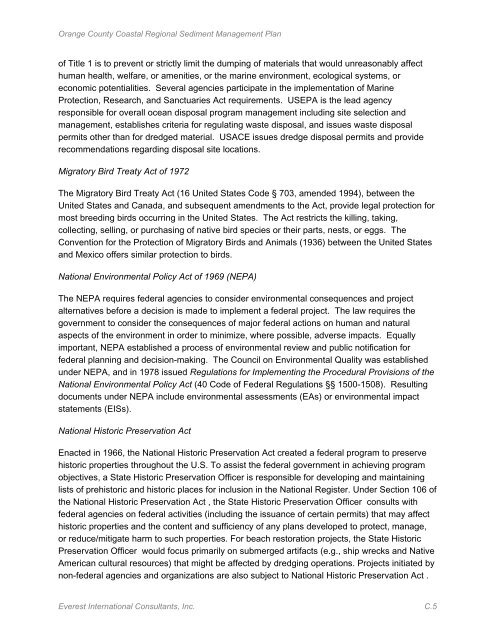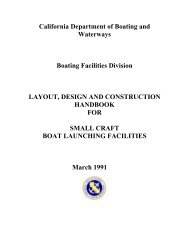EVEREST June, 2013 - California Department of Boating and ...
EVEREST June, 2013 - California Department of Boating and ...
EVEREST June, 2013 - California Department of Boating and ...
Create successful ePaper yourself
Turn your PDF publications into a flip-book with our unique Google optimized e-Paper software.
Orange County Coastal Regional Sediment Management Plan<br />
<strong>of</strong> Title 1 is to prevent or strictly limit the dumping <strong>of</strong> materials that would unreasonably affect<br />
human health, welfare, or amenities, or the marine environment, ecological systems, or<br />
economic potentialities. Several agencies participate in the implementation <strong>of</strong> Marine<br />
Protection, Research, <strong>and</strong> Sanctuaries Act requirements. USEPA is the lead agency<br />
responsible for overall ocean disposal program management including site selection <strong>and</strong><br />
management, establishes criteria for regulating waste disposal, <strong>and</strong> issues waste disposal<br />
permits other than for dredged material. USACE issues dredge disposal permits <strong>and</strong> provide<br />
recommendations regarding disposal site locations.<br />
Migratory Bird Treaty Act <strong>of</strong> 1972<br />
The Migratory Bird Treaty Act (16 United States Code § 703, amended 1994), between the<br />
United States <strong>and</strong> Canada, <strong>and</strong> subsequent amendments to the Act, provide legal protection for<br />
most breeding birds occurring in the United States. The Act restricts the killing, taking,<br />
collecting, selling, or purchasing <strong>of</strong> native bird species or their parts, nests, or eggs. The<br />
Convention for the Protection <strong>of</strong> Migratory Birds <strong>and</strong> Animals (1936) between the United States<br />
<strong>and</strong> Mexico <strong>of</strong>fers similar protection to birds.<br />
National Environmental Policy Act <strong>of</strong> 1969 (NEPA)<br />
The NEPA requires federal agencies to consider environmental consequences <strong>and</strong> project<br />
alternatives before a decision is made to implement a federal project. The law requires the<br />
government to consider the consequences <strong>of</strong> major federal actions on human <strong>and</strong> natural<br />
aspects <strong>of</strong> the environment in order to minimize, where possible, adverse impacts. Equally<br />
important, NEPA established a process <strong>of</strong> environmental review <strong>and</strong> public notification for<br />
federal planning <strong>and</strong> decision-making. The Council on Environmental Quality was established<br />
under NEPA, <strong>and</strong> in 1978 issued Regulations for Implementing the Procedural Provisions <strong>of</strong> the<br />
National Environmental Policy Act (40 Code <strong>of</strong> Federal Regulations §§ 1500-1508). Resulting<br />
documents under NEPA include environmental assessments (EAs) or environmental impact<br />
statements (EISs).<br />
National Historic Preservation Act<br />
Enacted in 1966, the National Historic Preservation Act created a federal program to preserve<br />
historic properties throughout the U.S. To assist the federal government in achieving program<br />
objectives, a State Historic Preservation Officer is responsible for developing <strong>and</strong> maintaining<br />
lists <strong>of</strong> prehistoric <strong>and</strong> historic places for inclusion in the National Register. Under Section 106 <strong>of</strong><br />
the National Historic Preservation Act , the State Historic Preservation Officer consults with<br />
federal agencies on federal activities (including the issuance <strong>of</strong> certain permits) that may affect<br />
historic properties <strong>and</strong> the content <strong>and</strong> sufficiency <strong>of</strong> any plans developed to protect, manage,<br />
or reduce/mitigate harm to such properties. For beach restoration projects, the State Historic<br />
Preservation Officer would focus primarily on submerged artifacts (e.g., ship wrecks <strong>and</strong> Native<br />
American cultural resources) that might be affected by dredging operations. Projects initiated by<br />
non-federal agencies <strong>and</strong> organizations are also subject to National Historic Preservation Act .<br />
Everest International Consultants, Inc. C.5




